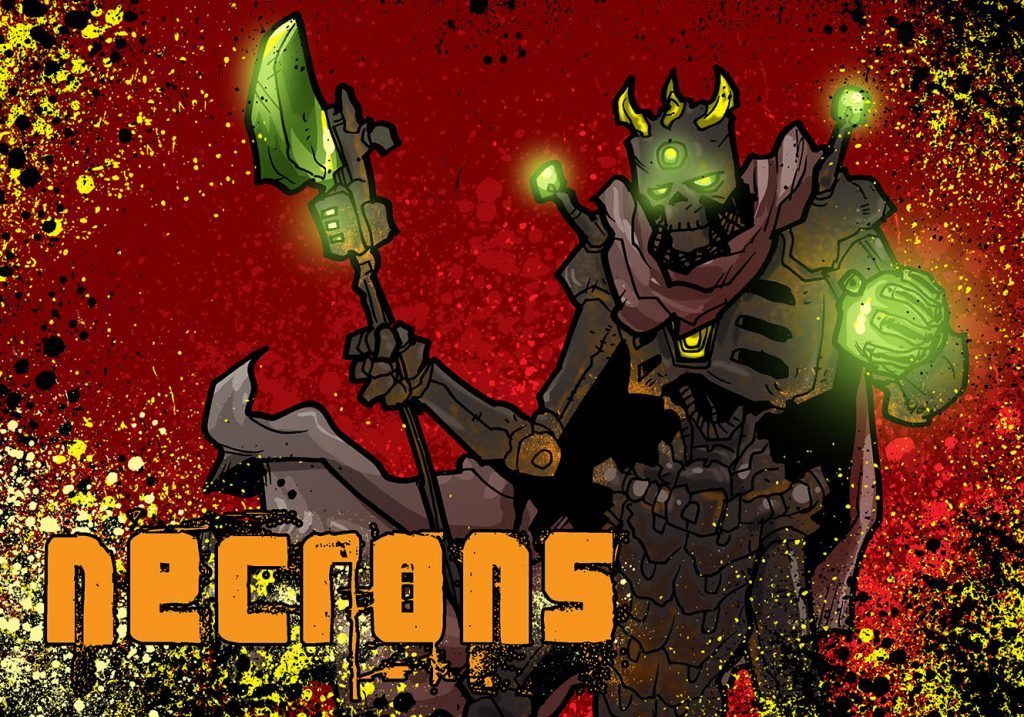
Dolch here again.
Like all Necron players, I’ve been holding my breath for news about the Necron Codex that is coming in October.
While I don’t think that our army lives or dies by the fate of Reanimation Protocols, it remains one of the big mysteries of the new edition.
So… I’ll look ahead by looking backward…
On a personal note, I started with Necrons in 2011. I didn’t buy that 3rd edition codex… with its Phase Out rules and Pariahs. Instead, I waited for the 5th edition book. Well, now that I’m in a different place in my life, I’ve recently found copies of not only that 3rd edition book but also the Chapter Approved from 2001.
Oh… and since the army is almost a decade old, I also decided that it needs some touchup… finally rebasing my warriors and lychguard. You know… all the things that I’ve neglected to do over the years. Oh… and priming and basecoating the new Indomitus models…

2001 – Chapter Approved
Necrons were included in Chapter Approved after appearing in a series of White Dwarf articles.
The rule at the time was called “We’ll Be Back”.

When a Necron Character, Warrior, or Immortal model was reduced to 0 wounds, you would lay it down on the table rather than remove it from the game. Ignore unit coherency, they amounted to battlefield debris to your opponent. If at the start of every Necron turn, if there was a model of the same type within 6 inches. On a 4+ the model will get up and join that unit (move it to within 2-inch coherency). Lords didn’t need another Lord within 6, and would only return with a single wound. If the We’ll Be Back roll failed, then you would remove the model like normal.
Necron models that died to weapons with the Instant Death special rule are removed immediately and did not make a We’ll Be Back roll.
The interesting part is that for whatever reason, Destroyers were excluded. The rule only applied to Lords, Warriors and Immortals.
2003 – 3rd Edition Codex
Necrons get their first proper codex and a large expansion to their model line.
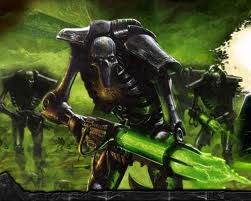
We’ll Be Back doesn’t change a lot between the Chapter Approved and Codex versions. You are still laying Necrons down, they still get back up on a 4+. You still need to have a unit of the same type within 6 inches for the model to join.
Resurrection Orbs could overcome the restriction against resurrecting models that died due to weapons with Instant Death. Spyders allowed you to overcome the restriction of a similar unit in range. As long as a Spyder was within 12 and there was another similar unit on the table, you could make the roll and have the model join that unit.
Monoliths had an option to move a unit from anywhere on the table back to the Monolith. When doing so, any models that failed their We’ll Be Back roll at the beginning of the turn get a second chance. This was huge, and good Necron players were able to take advantage of these synergies.
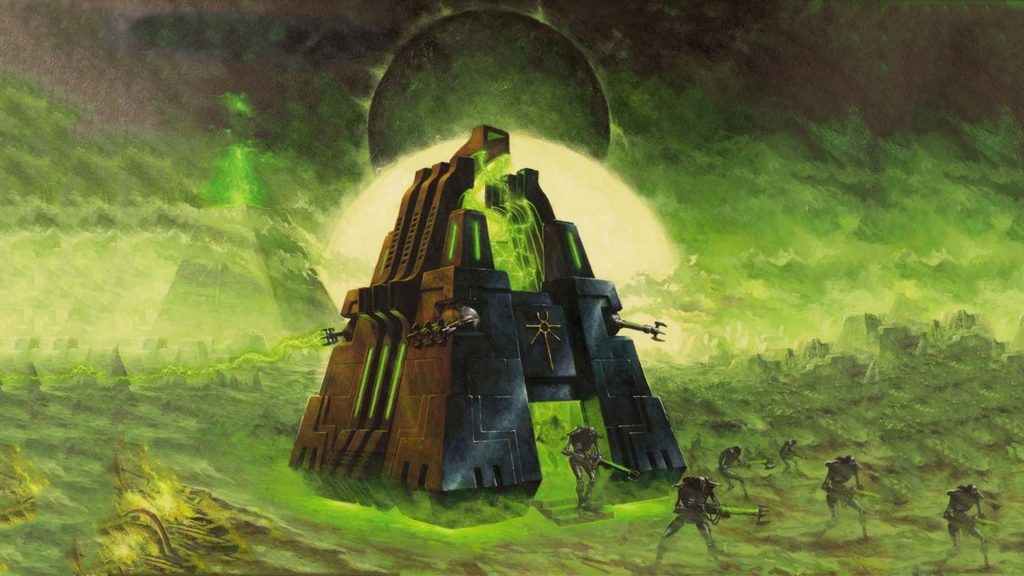
This army list included a lot more Necron units… namely Flayed Ones, Destroyers, Heavy Destroyers, and Wraiths. Scarabs, Spyders, and the Pariahs didn’t carry the Necron keyword. Neither did the c’tan characters, The Nightbringer and The Deceiver.
2011 – 5th Edition Codex
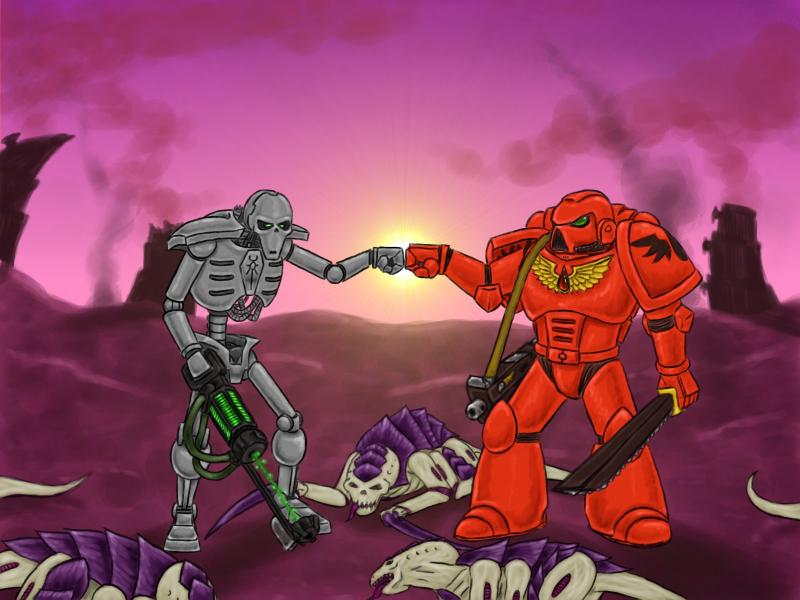
Ahh… the infamous 5th Edition Ward Codex… the Necron model line received a huge expansion and the lore received a major overhaul. Gone are the mindless hordes intent on destruction… and now the character models have complex, human-like motivations (and plenty of back-stabbing and in-fighting). I’m biased because this is when I came into the game, but there was a lot to love in this codex.
We’ll Be Back got a major change! No longer is it reliant on the tagline of a 20-year-old movie. Instead of tipping over models, you get to add a counter to the unit.

Reanimation rolls were taken at the end of each phase. On a 5+, the model returns in coherency with their unit and can act like normal.
Fall back was a thing back then, and if the unit made a fall back move the counters were lost.
Necron Characters got Ever-Living in addition to Reanimation Protocols. This eliminated the need for a Character to get back up into a unit. If your opponent was wily, they could just carefully move their unit in a way to eliminate your ability to bring that character back.

This codex also introduced us to the Royal Court and Crypteks. It’s hard to imagine, but crypteks didn’t have the Technomancer rule and had no bearing on Reanimation Protocols. However, you could have as many as five Lords in your royal court, and each lord could have a Reanimation orb to spread out to your various units. Reanimation Orb also changed, allowing Reanimation Protocols on a 4+ for the bearer and his unit.
We also got the Repair Barge ability on the Ghost Arks. While not strictly affecting Reanimation Protocols, its ability to add up to D3 models back to a unit of Warriors (at the chance of taking a glancing hit) served a similar role.
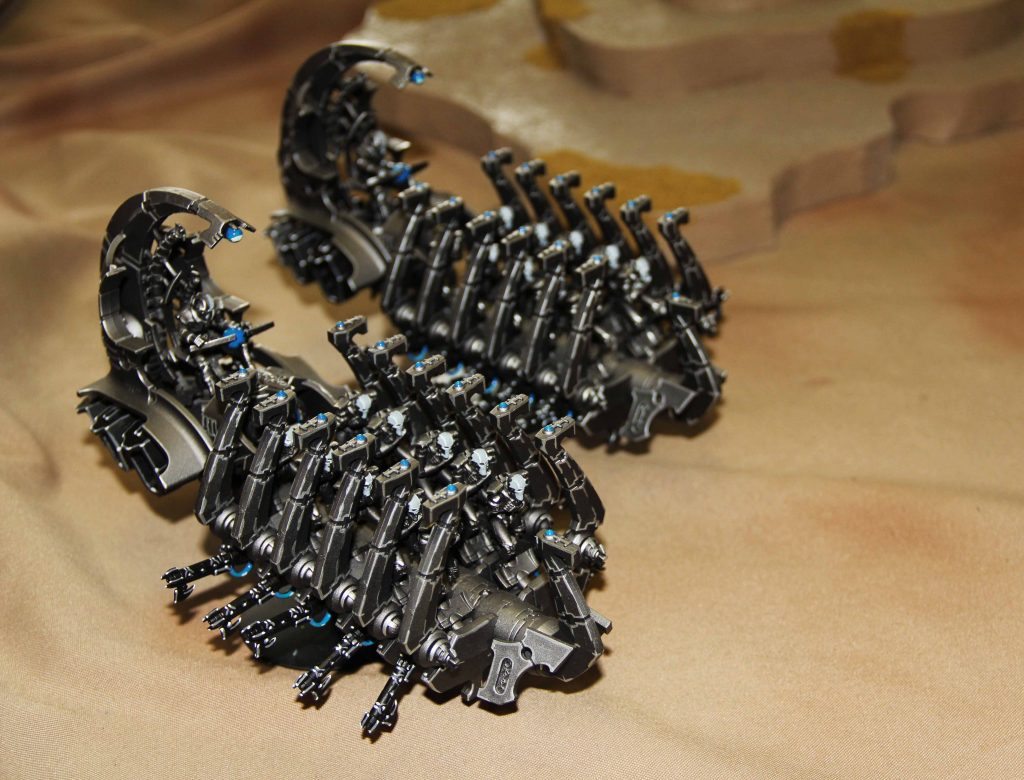
Wraiths moved into the Canoptek category so lost Reanimation Protocols. We gained several units that have the Reanimation Protocol rule, namely Deathmarks, Triarch Praetorians, Lychguard, and Tomb Blades.
2015 – 7th Edition Codex
Our 7th edition codex is the one that introduced the infamous Decurion Detachment… more on that in a bit.
Huge change to Reanimation Protocols in this edition as it became an additional save after a unit took an unsaved wound. You succeeded on a 5+, but there were a few modifiers. If the weapon had instant death, you were at a -1. Other abilities, specifically those below, could increase your chance to save but never better than a 4+. Destroyer weapons completely removed the chance to make a Reanimation Protocol save, and you couldn’t take a RP and Feel No Pain.
Here, Crypteks gained the familiar Technomancer rule. Models in its unit, gain a +1 on their Reanimation Protocol rolls.
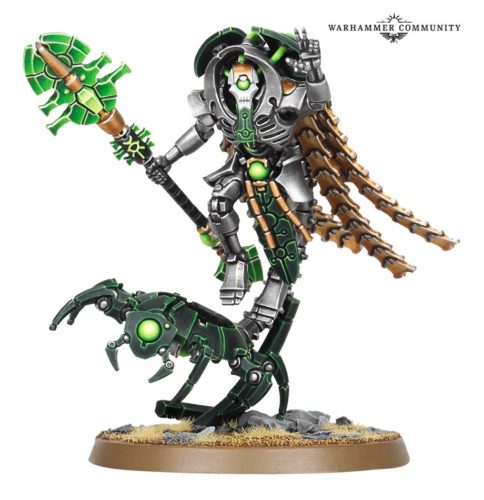
Resurrection Orbs became one-time-use items that granted the ability to reroll failed Reanimation Protocol saves taken during this phase.
Repair Barge returns for Ghost Arks. Similarly returning up to D3 models to warrior units, but now you don’t need to risk taking a glancing hit.
The Reclamation Legion benefit allowed the Overlord and units within 12 inches of him to reroll their Reanimation Protocol save. However, most importantly, the Decurion Detachment gave the whole detachment a native +1 to their Reanimation Protocols. This allowed you to place a Cryptek near where your opponent’s Instant Death weapons and still cover that corner of the battlefield with a 4+ Reanimation Protocol.
This was the high-water mark for the effectiveness of Reanimation Protocols, but given the state of the game at the end of 7th edition that isn’t saying a whole lot.
2017 – Index
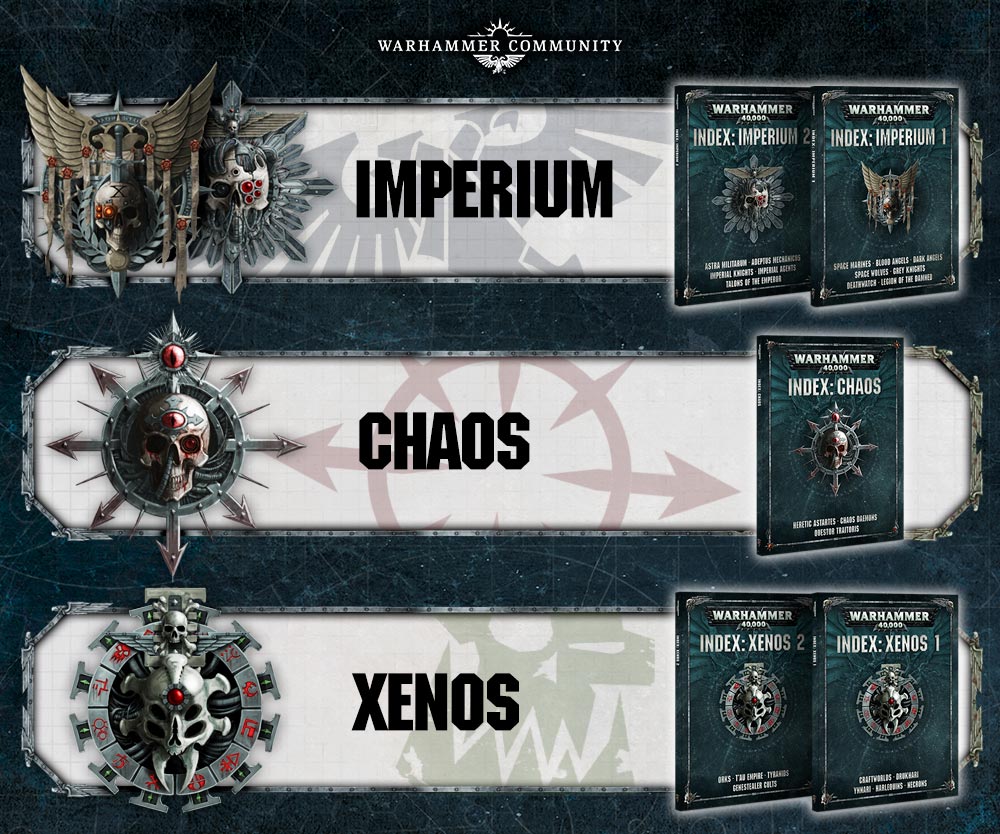
Index 40k let Necrons make Reanimation Protocol rolls for any model that was missing from its unit at the beginning of the turn. Models return on a 5+. Units were allowed to return models as long as the unit had not been wiped out. The Cryptek’s Technomancer remained unchanged, except for the addition of a 3” aura. While there is no expressed limit to improving a unit’s Reanimation Protocol, the individual auras did exclude each other… so we were limited to a 4+.
Resurrection Orbs allowed for a one-time reroll on RP within a 3” area around the model. Ghost arks let you make Reanimation Protocols for units embarked, even though they weren’t on the battlefield. They also let you make a second Reanimation Protocol roll for any single unit within 3 inches at the end of the movement phase. Good rules, but not enough for most players to want to play with Warriors.
2018 – 8th Edition Codex
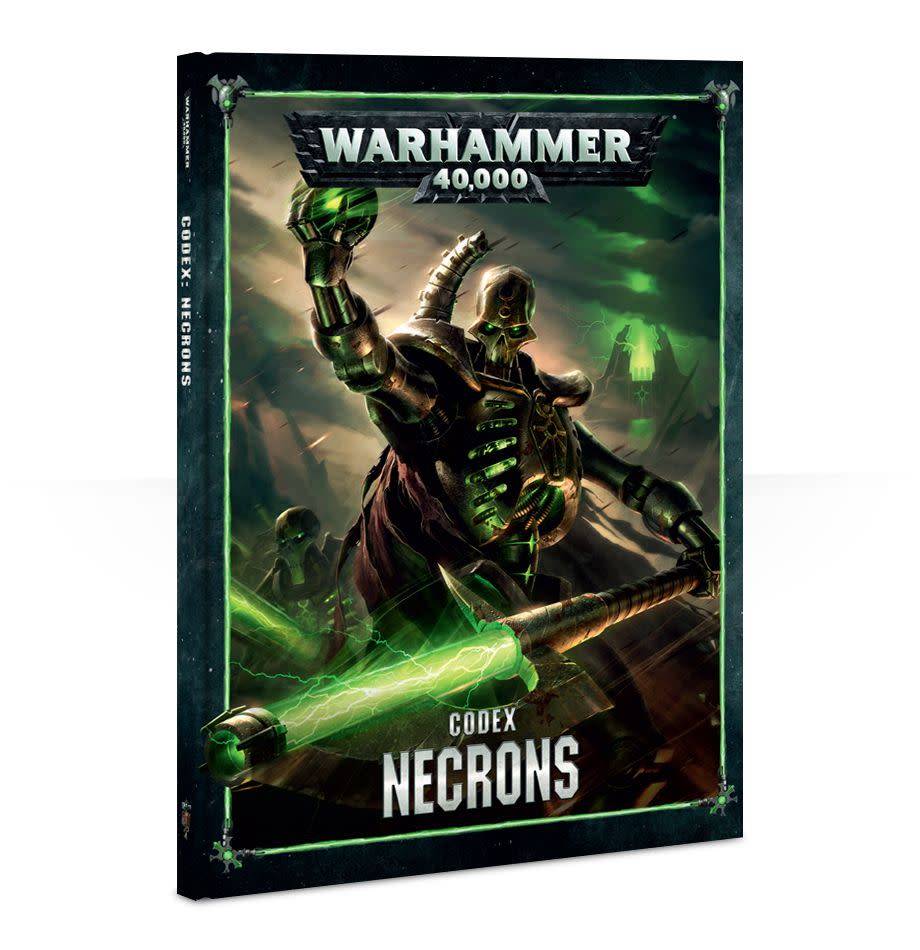
Our 8th edition codex came and didn’t make too many changes to the basic Reanimation Protocol rule from the Index. They did add that the model returned with their full wounds. Models can keep making RP Saves even in turns after they have been removed from the game, but you need to keep track of any that you lost due to morale, as they are not allowed to return.
The Technomancer and Master Technomancer abilities worked the same as Index, so did Resurrection Orbs. Ghost Arks allow you to make a second RP roll for that unit of warriors but didn’t risk taking a wound.
The 8th edition Codex added relics, Command Traits, Dynastic Codes, and stratagems.
Wisely, Games Workshop didn’t have any Dynastic Codes boost Reanimation Protocols. We do have a pair of stratagems and a relic.
- Enhanced Reanimation Protocols is a 2 CP stratagem that allows you to reroll RP Rolls of 1 for one unit this turn.
- Repair Subroutines is a 2 CP stratagem that allows a Canoptek unit to gain Reanimation Protocols for the rest of the turn.
On the relic side of things, you can take the Orb of Eternity… which acts like a normal Resurrection Orb but you get to add 1 to the result.
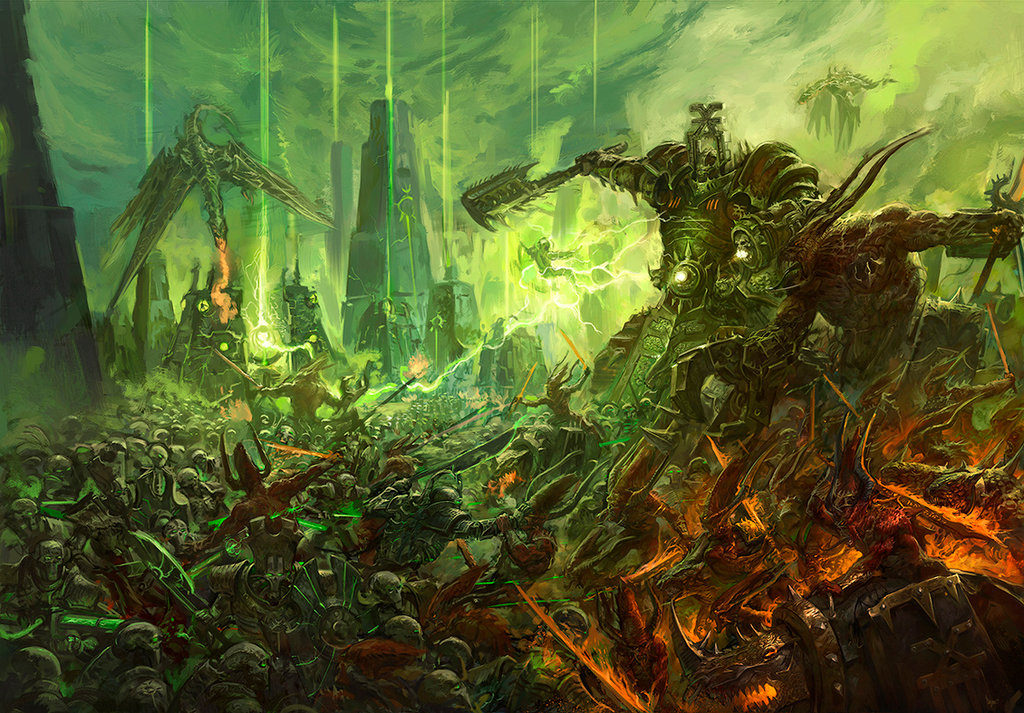
So, where does RP stand today?
The current version of the rule is unbalanced in terms of game size and unit size. It also leads to uninteresting play decisions.
In small points games, Necron Reanimation Protocol can be overwhelming for an opponent… if you don’t have a lot of firepower it can be a struggle to remove units completely. Even crippled Necron units can return to effectiveness if left alone for a turn or two. Reanimation protocols plays almost no role in large games. At higher point levels, removing units is almost trivial and it is pretty easy to eliminate any partial units.
Many Necron units have small model sizes and are very expensive on a per-model basis. At these small sizes, it doesn’t take much firepower to completely remove a unit. Reanimation Protocols really does its best work with very large units. These units are more likely to be able to weather attacks and survive long enough to get a chance at getting back up. However, these models are also pretty expensive for what you get, and a 20 man unit of warriors takes a significant portion of your armies points, meaning that you will want to support them with things like a Ghost Ark and/or Cryptek with Chronometron for a 5+ invulnerable save against shooting. Many players have been excluding warriors from their army lists, going with smaller units of Immortals, and saving a lot of those points for other types of units in our army.
Ultimately, there is very little in terms of interesting target priority for the opponent of a Necron army.
- Is there a partial unit of Necrons on the board? If yes, kill it.
- If no, pick the next unit that I am likely to kill with the firepower I have remaining.
This is an issue for both competative and narrative play… simple decision trees like this make for less interesting games.
What does the new addition need?
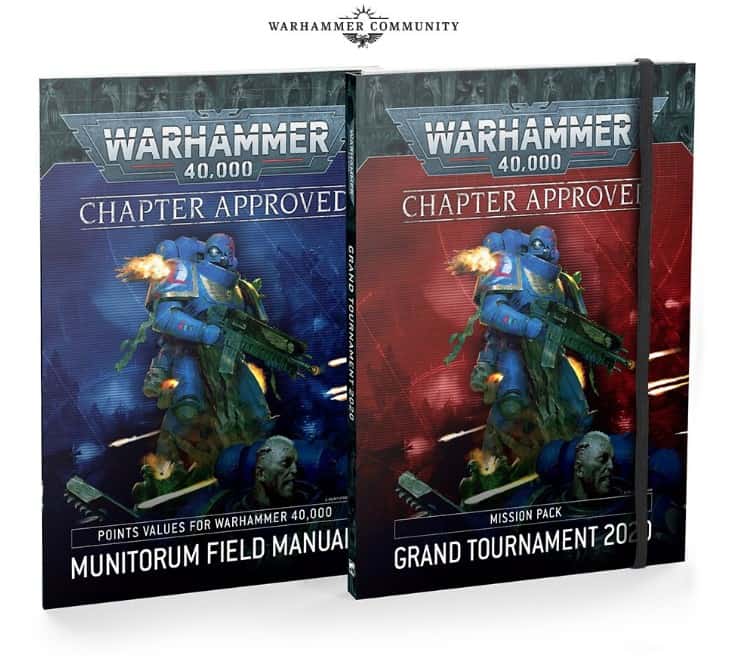
The cleanest implementation of Reanimation Protocols was probably the 7th edition version. You weren’t keeping track from turn to turn, and models who made the save were able to participate in the rest of the turn. The downside of this is that there were other rules in the game that operated the same way (Feel No Pain), and it didn’t have a unique character that Necron players and Games Workshop wanted for the army.
Every other version of Reanimation Protocols had some form of clunky bookkeeping or required additional rules in the moral or movement phases.
The version from 8th would be a lot better if it was on a per-wound rather than a per-model basis. This would allow units like Destroyers with multiple wounds to make more reanimation protocol rolls, as you would be able to roll on wounded models.
Ultimately, I think the most important fix to Reanimation Protocols won’t come with the rule itself, but the support that we can get from other units and stratagems.
Similarly, the new edition already has better terrain rules, which will allow us to hide parts of those big units out of sight… this will help.
If we had a stratagem that would disrupt our opponents shooting priority, we could save more of our units from being burned down on a single turn. Even splitting an opponent’s shooting into 2 units would be a benefit.

So… did I miss anything? Am I wrong? Do you want to congratulate me on squeezing over 30 years of pop culture references into this article?
If so, leave me a comment below!
Until then,
Best Blitzes!
Dolch
Subscribe to our newsletter!
And remember, Frontline Gaming sells gaming products at a discount, every day in their webcart!




an interesting analysis …
the new edition now has Skorpekh Destroyers reanimating … I learnt to my cost last week-end to remove them with my eradicators melta-rifles, rather than melee with my Bladeguard Veterans.
I like the unique gimmick of the Necrons having living metal and reanimation protocols – compared to the DR save for DG. I’m experimenting with the “Indomitus” models using the block of 20 warriors. They are doing well so far. The canoptek reanimator helps get the 4+ for RA, but seems expensive.
And of course Terminator was first shown in 1984 and the words were recorded from General MacArthur in 1942.
Thanks!
Why not just give every model a single chance (ever) to get a chance to stand back up, and that roll can be made regardless of the presence, or lack of presence, of any friendly or enemy models?
Interesting idea, but problematic.
The Necron player has the bottom of the turn, and is able to reanimate 20% of his models on objectives the last turn of the game. His opponent wouldn’t have an opportunity to react, and if objectives were open, would lose the game. It feels very much like a ‘gotcha’.
The main problem I see is that the rule will get wordy to cover the case of the last model, um, standing (?). I don’t think it’s an issue that you tried to kill a unit that hadn’t yet lost any models at the top of turn 5, and then at the bottom of turn 5 your Necron opponent uses those extra models to steal an objective. That’s a pretty corner case that sounds like you made a mistake somewhere along the way, rather than the rule being overly potent.
Yarium, maybe I misunderstood your proposal.
Here are the main things I want to see Reanimation Protocol (or Necron army-wide rules in general) address.
#1. It has to be interesting. Simply having another save to work through before you remove the model isn’t interesting. Death Company does that. Deathguard does that. Nurgle does that. Necron reanimation needs to be different. It needs to lead to interesting play decisions for me and for my opponent.
#2. Necron reanimation needs to be balanced for large and small point games, as well as for large and small units. We are going to be paying for this ability, and we need to be able to make use of it even at Onslaught. It needs to be fun to play against, even at Combat Patrol. Similarly, it would be great to have similar levels of utility for a 20-man warrior blob, and a 3-man destroyer squad.
#3. Finally, it needs to be handled in a way that the reanimated models are actually useful on the table (not just ablative wounds). It is not very fun to have models that never get to shoot or attack in close-combat because they keep bouncing back from the killed pile.
Scoring is done at the top of the turn, though, so reanimating for the bottom of the turn would be irrelevant.
It would not be irrelevant, only differently relevant. Consider: it’s your turn, you’re playing Necrons. You send your squad of 10 remaining Warriors to charge an objective held by MSU Marines, who easily kill 8 of them, and so retain control of the objective. But through some luck, enough Warriors reanimate to claim the objective for their own, removing it from the opponent and preventing them from scoring.
Thematic? Absolutely. Fair? Possibly. Irrelevant? No. Current rules would allow Warriors the chance to reanimate and control the objective before scoring primaries for the round is done. It would encourage differences to style of play, and I’m not really sure whether the direction would be favorable to Necrons or their opponents.
For myself, I think that the ideal solution is to give squads a chance to use reanimation protocols even if wiped out on a roll of 6 – roll a 6, and then you get to use RP as normal, fail and squad is gone for good. Maybe limit to just troops.
I have been working on a Necron fan codex, and would like to submit the (admittedly very involved) reanimation protocol rule that I’ve come up with.
It is just like the Angels of Death rule in that it really encompasses 4 rules under one name. It would apply to all of the same models (including characters) that RP currently applies to. I would love any and all feedback including the likes of “it’s too complicated!” “this sucks!” etc.
Reanimation Protocols
Any model with this rule has the Repair Protocols, Tomb Teleportation, Failsafe Protocols, and Living Metal special rules.
Repair Protocols:
If, at the end of your Command phase, you have any units with this ability that have suffered any casualties roll a dice for every model originally included in the unit. For every roll of a 5+, return a previously slain model to the unit, within 2” of a model that began the game in the unit, with 1 wound remaining. If at any point the last remaining model in a unit with this rule would be removed, it is said to be returned to the tomb and the entire unit including all previously destroyed models that had not yet been returned to the table enters Reserves. That unit does not count as having been destroyed unless every model in the unit is returned to the tomb at the end of the game, when calculating points scored at the end of the game. Units that have returned to the tomb still benefit from reanimation protocols, however, only once all models in a unit have been returned to the unit, can the unit enter from reserves, as described below.
Tomb Teleportation:
Units entering from Reserve via the returned to the tomb rule must roll a D6 and consult the chart below. If the unit cannot be set up per the restrictions of the roll, the unit may not arrive from reserves this turn:
Dice Roll
Effect
1
Your opponent chooses a table edge. The unit must be set up wholly within 6” of that table edge, further than 9” away from any enemy models, and more than 3” from any objectives.
2
You choose a table edge that may not be your opponent’s table edge. The unit must be set up wholly within 6” of that table edge, further than 9” away from any enemy models, and more than 3” from any objectives.
3
You choose any table edge. The unit must be set up wholly within 6” of that table edge, further than 9” away from any enemy models, and more than 3” from any objectives.
4
Your opponent chooses a table quarter. The unit must be set up wholly within 6” of that table quarter, further than 9” away from any enemy models, further than 6” of the center of the table, and more than 3” from any objectives.
5
You choose a table quarter. The unit must be set up wholly within 6” of that table quarter, further than 9” away from any enemy models, further than 6” of the center of the table, and more than 3” from any objectives.
6
You may set up the unit anywhere on the battlefield further than 9” away from any enemy models, and more than 3” from any objectives.
Failsafe Protocols:
Models removed during the Morale phase are returned to the tomb instead.
Living Metal:
If a model with this ability has suffered any wounds over the course of the battle, it regains one wound at the start of each of your Command phases, up to its starting value. Models must be on the table to benefit from this ability.
Thanks for reading all the way to the end!
Paul,
I love reading your fandex work. Please keep it up!
Your systems feels very 3rd or 5th edition, with the inclusion of the table. That may be what you are going for.
Here’s an idea that I’ve batted around with buddies for a while. See what you think.
“When the last model of a unit with the Reanimation Protocol rule is removed from play, replace that model with a Reanimation Counter. At the beginning of each Necron Player turn make Reanimation Protocol rolls for models in that unit as normal.”
Add an action that an opposing unit can take. “Repair THIS!” You can take this action while within engagement range of a Reanimation Counter. Until the start of your next turn, you may not shoot or assault. Remove the Reanimation Counter.”
I just love the image of a unit spending it’s time kicking Necron pieces apart and squishing scarabs rather than doing anything else.
“The interesting part is that for whatever reason, Destroyers were excluded. The rule only applied to Lords, Warriors and Immortals”
There was a rule that if the Destroyer died. His just ditched the bike and became a warrior on foot. So he is get I’ll Be Back just not his bike.
Nice list.
It is important to note that in the earlier editions the RP/I’ll be back rules were on units that were at (warriors) and better (Immortals) then Space Marine models statline wise. They costed more too but taking out Warriors and Immortals was not easy like today where a stack of 20 Warriors is a joke to remove with ease.
Pyrothem,
I did miss that destroyer bit when I dug through the Chapter Approved. Thanks for the heads-up!
You are right. Warriors have slipped a bit compared to normal Space Marines, and Immortals haven’t been better for a while.
One idea I’ve had is to give them something like GSC cult ambush, only you place a “reanimation protocols” token within 3″ of the last model killed in a unit when it gets wiped out. You should have a finite number of these to use during the game depending on game size, or they should be limited in some other way (and maybe certain characters or items can give you more). At the end of your movement phase, make a reanimation protocols roll for the entire unit to determine how many models you get back, and deploy those models wholly within 3″ of the marker and not within 1″ of enemy models. Any models that can’t be placed are destroyed, and the marker is then removed. It could be balanced by requiring more tokens for larger or more powerful units.
I think it gives a suitable “they just won’t stay down” vibe to the army, gives the necron player decisions to make about when to use his/her limited number of tokens and where to place them, and gives the opponent a way to counter it by trying to draw tokens out on less powerful or out-of-position units or trying to maneuver so that tokens can’t be placed optimally.
A one-time use deployment strategem that doesn’t depend on a vehicle would be cool.
I think that Necrons had a mission with Blip deployment back in 4th edition.
Hopefully, GSC will get a new codex sooner rather than later. That will tell us exactly how much tolerance the Game Workshop Design Studio has for wonky rules… I do hope that they get a balanced, flavorful codex.